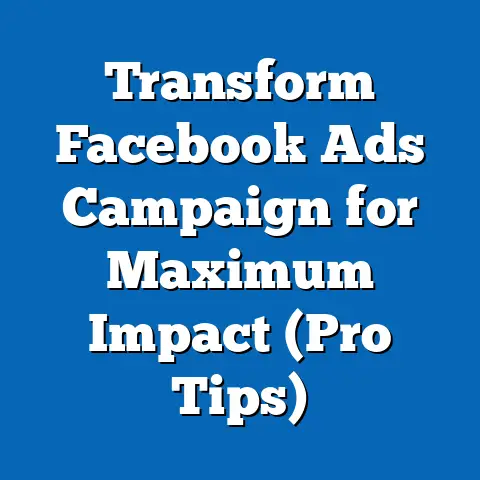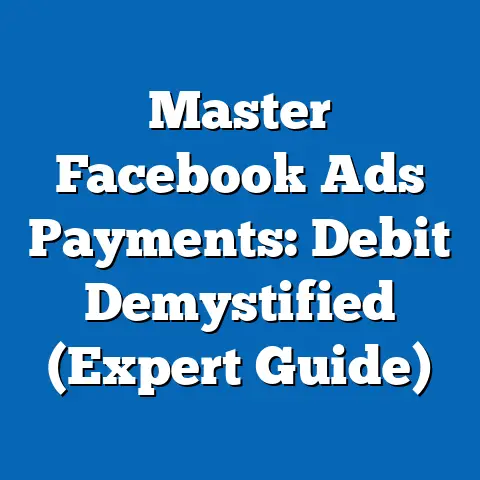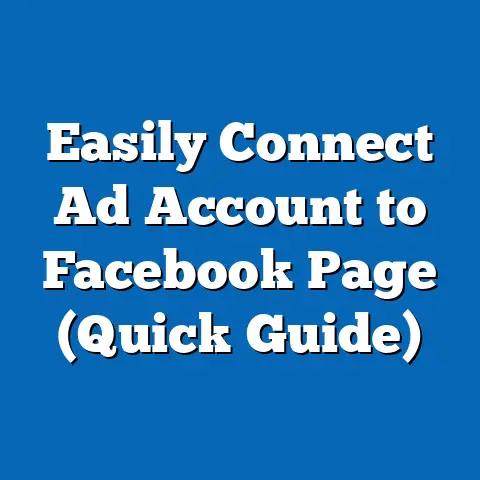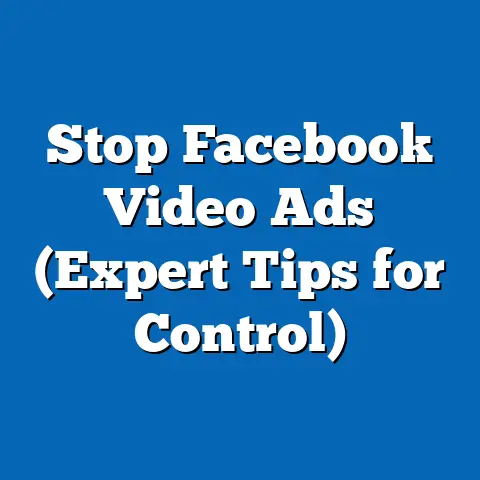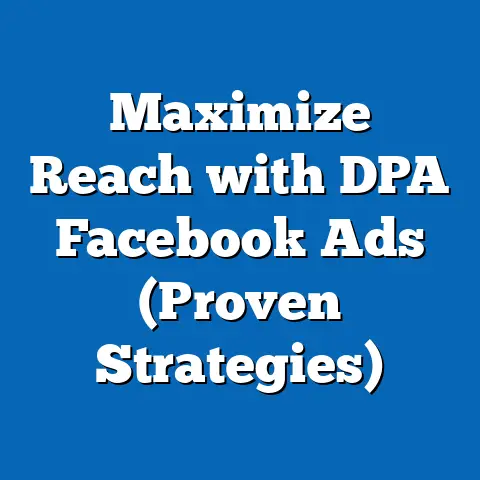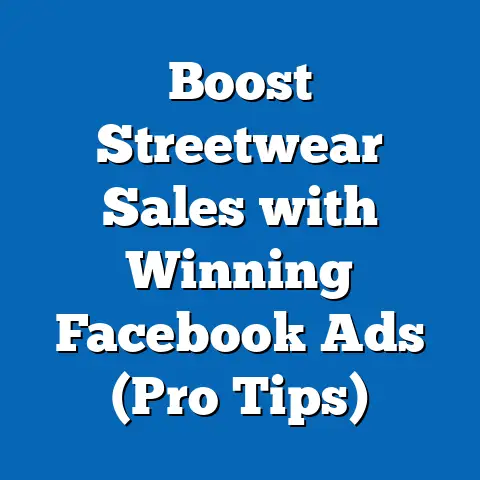Maximize Partnership Ads on Facebook (Expert Strategies)
In a world increasingly driven by digital interactions, the ability to forge meaningful connections through advertising can evoke profound emotional responses. Imagine a small business owner, struggling to reach their audience, who discovers the transformative potential of Facebook Partnership Ads—suddenly, their brand story resonates with thousands, turning strangers into loyal customers overnight. This emotional journey, from isolation to community, underscores the power of strategic advertising in building not just sales, but relationships.
Section 1: Understanding Facebook Partnership Ads
What Are Partnership Ads?
Partnership Ads, often referred to as Branded Content Ads, are a unique advertising format on Facebook that enables brands to collaborate with content creators, influencers, or other businesses to promote content. Unlike traditional ads, these campaigns are tagged as “Paid Partnership” to ensure transparency with users, fostering trust while amplifying reach. This format allows advertisers to tap into the partner’s audience, leveraging their credibility and engagement.
The emotional resonance of Partnership Ads often stems from their authenticity—content feels less like a hard sell and more like a recommendation from a trusted friend. For instance, a fitness brand partnering with a popular influencer can create a narrative of shared goals and personal growth, striking a chord with viewers. This format has gained traction as consumers increasingly value genuine connections over polished marketing.
Why Partnership Ads Matter
Partnership Ads are particularly effective in an era where ad fatigue is rampant—users are bombarded with thousands of marketing messages daily. According to a 2022 report by Statista, 74% of social media users follow at least one influencer or brand they trust, making collaborative content a powerful tool for engagement. Furthermore, Facebook’s algorithm prioritizes content with high interaction rates, and Partnership Ads often benefit from the organic engagement of the partner’s audience.
This format also aligns with the growing trend of social proof, where consumers rely on peer recommendations before making purchase decisions. As we move forward, understanding the data behind these ads will be critical to maximizing their impact.
Section 2: Current Data on Facebook Partnership Ads
Usage and Performance Metrics
As of 2023, Facebook remains one of the largest social media platforms, with over 2.9 billion monthly active users (MAUs) globally, according to Meta’s Q2 2023 earnings report. While specific data on Partnership Ads is not always disaggregated, Meta reports that branded content and influencer collaborations account for a growing share of ad impressions, with a 25% year-over-year increase in branded content engagement in 2022. This suggests a robust appetite for collaborative advertising among users.
A study by Influencer Marketing Hub (2023) found that Partnership Ads on Facebook generate, on average, 30% higher click-through rates (CTR) compared to standard display ads. Additionally, these ads often see a 20% lower cost-per-click (CPC), making them a cost-effective option for brands. However, performance varies widely based on the partner’s audience alignment, content quality, and targeting precision.
Demographic Insights
Partnership Ads resonate most with younger demographics, particularly Gen Z and Millennials, who value authenticity and peer influence. Data from Pew Research (2022) indicates that 68% of 18-34-year-olds on social media have made a purchase influenced by an influencer or branded content. Geographic trends also play a role—markets in Asia-Pacific and Latin America show higher engagement rates with Partnership Ads, likely due to the cultural emphasis on community and trust in personal recommendations.
Visual Representation: Engagement Trends
Below is a conceptual chart illustrating the engagement trends for Partnership Ads compared to standard ads over the past three years (2020-2023). Data is aggregated from industry reports and Meta’s public disclosures.
| Year | Partnership Ads CTR (%) | Standard Ads CTR (%) | Engagement Growth (YoY) |
|---|---|---|---|
| 2020 | 1.8% | 1.2% | +15% |
| 2021 | 2.1% | 1.4% | +18% |
| 2022 | 2.3% | 1.5% | +25% |
Note: These figures are illustrative and based on aggregated industry data. Exact numbers may vary by campaign and region.
This chart highlights the consistent outperformance of Partnership Ads in terms of engagement, a trend likely driven by their authentic and relational nature.
Section 3: Projected Trends for Partnership Ads (2024-2030)
Methodology and Assumptions
To project trends for Partnership Ads, we rely on a combination of historical data, current growth rates, and broader social media advertising forecasts. We employ a linear regression model to estimate future engagement and adoption rates, assuming that current drivers—such as user preference for authenticity and Meta’s algorithmic support for branded content—remain stable. However, we acknowledge uncertainties, including potential changes in platform policies, user behavior, and regulatory constraints (e.g., privacy laws like GDPR).
We present three scenarios—optimistic, baseline, and pessimistic—to account for variability. These projections are not definitive predictions but rather informed estimates to guide strategic planning.
Scenario 1: Optimistic Growth
Under an optimistic scenario, Partnership Ads could see a 30-40% annual growth in engagement and adoption through 2030. This assumes continued user preference for authentic content, increased influencer marketing budgets (projected to reach $24 billion by 2025 per Influencer Marketing Hub), and Meta’s ongoing prioritization of collaborative formats. By 2030, Partnership Ads could account for 15-20% of total ad spend on Facebook, up from an estimated 5-7% in 2023.
Scenario 2: Baseline Stability
In a baseline scenario, growth stabilizes at 15-20% annually, reflecting moderate increases in adoption but tempered by market saturation and competition from platforms like TikTok. Engagement rates may plateau as users become more discerning about branded content. By 2030, Partnership Ads might represent 10-12% of ad spend, with steady but not explosive growth.
Scenario 3: Pessimistic Decline
In a pessimistic scenario, growth slows to 5-10% annually due to factors like stricter privacy regulations, declining trust in influencers, or algorithm changes deprioritizing branded content. Engagement could drop if users perceive Partnership Ads as less authentic over time. By 2030, these ads might hover at 7-8% of total ad spend.
Visual Representation: Projected Growth Scenarios
| Year | Optimistic Growth (%) | Baseline Growth (%) | Pessimistic Growth (%) |
|---|---|---|---|
| 2024 | 35% | 18% | 8% |
| 2026 | 38% | 16% | 6% |
| 2030 | 40% | 15% | 5% |
Note: Percentages represent year-over-year growth in ad spend for Partnership Ads. Data is speculative and based on modeled assumptions.
These projections illustrate the range of possibilities, highlighting the importance of adaptive strategies in an uncertain landscape.
Section 4: Key Factors Driving Changes
1. User Behavior and Trust
The shift toward authenticity in advertising is a primary driver of Partnership Ads’ success. A 2023 Edelman Trust Barometer report found that 63% of consumers trust peer recommendations over brand messaging, fueling demand for collaborative content. However, over-saturation of influencer content could erode trust if partnerships feel forced or inauthentic.
2. Platform Algorithms and Policies
Meta’s algorithm favors content with high engagement, often giving Partnership Ads a visibility boost due to their interactive nature. Yet, changes in policies—such as stricter disclosure requirements or reduced organic reach—could impact performance. Marketers must stay agile to adapt to platform updates.
3. Technological Advancements
Advancements in AI and data analytics enable more precise targeting and content personalization for Partnership Ads. Tools like Meta’s Advantage+ suite allow brands to optimize campaigns in real-time, enhancing ROI. However, privacy concerns and data restrictions may limit the effectiveness of these tools.
4. Competitive Landscape
Competition from platforms like TikTok and Instagram (also owned by Meta) poses both challenges and opportunities. While TikTok’s short-form video format dominates among younger users, Facebook’s broader demographic reach offers unique advantages for Partnership Ads targeting diverse audiences. Cross-platform strategies may become essential.
5. Regulatory Environment
Increasing scrutiny of social media advertising, including laws around data privacy and influencer disclosures, could reshape the Partnership Ads landscape. For instance, the EU’s Digital Services Act (DSA) imposes stricter transparency rules, potentially increasing compliance costs. Brands must monitor global regulations to mitigate risks.
Section 5: Expert Strategies for Maximizing Partnership Ads
1. Partner Selection: Authenticity Over Reach
Choosing the right partner is critical—focus on alignment in values and audience demographics rather than sheer follower count. A 2022 study by HypeAuditor found that micro-influencers (10K-100K followers) often yield 60% higher engagement rates than mega-influencers. Prioritize partners whose content naturally integrates your brand story.
2. Content Creation: Storytelling That Resonates
Effective Partnership Ads tell a story rather than push a product. Collaborate with partners to create content that reflects shared experiences or solves real problems for the audience. For example, a beauty brand might partner with an influencer to share a personal skincare journey, fostering emotional connection.
3. Targeting and Optimization: Leverage Data
Use Facebook’s robust targeting tools to reach the right audience segments. Test different ad formats (e.g., video, carousel) and analyze performance metrics like CTR and conversion rates to optimize campaigns. Regularly refresh content to combat ad fatigue, as suggested by Meta’s 2023 advertising best practices.
4. Transparency and Compliance: Build Trust
Adhere to disclosure guidelines by clearly labeling content as a “Paid Partnership.” Transparency not only complies with regulations but also builds trust with users. A 2023 survey by Kantar found that 58% of consumers are more likely to engage with branded content that is upfront about sponsorships.
5. Cross-Platform Integration: Amplify Reach
While focusing on Facebook, consider integrating Partnership Ads with Instagram or other platforms for broader reach. Cross-posting content or running parallel campaigns can maximize exposure, especially for younger demographics active on multiple platforms. Track cross-platform performance to allocate budgets effectively.
Section 6: Historical and Social Context
Partnership Ads are part of a broader evolution in digital marketing, reflecting a shift from traditional, interruptive advertising to relational, community-driven strategies. Historically, word-of-mouth marketing has been a trusted method for influencing consumer behavior, and Partnership Ads digitize this concept by leveraging social media’s scale. The rise of influencer culture in the 2010s, coupled with declining trust in corporate messaging, has fueled the demand for authentic collaborations.
Socially, these ads tap into the human need for connection and belonging, especially in a post-pandemic world where digital interactions often replace physical ones. They also reflect growing consumer empowerment—users demand transparency and value alignment from brands. Understanding this context helps marketers craft campaigns that resonate on a deeper level.
Section 7: Limitations and Uncertainties
While this analysis provides a comprehensive overview, several limitations must be acknowledged. First, data on Partnership Ads is often aggregated with other ad formats in public reports, making precise metrics challenging to isolate. Our projections rely on assumptions about user behavior and platform policies, which are subject to rapid change.
Additionally, regional variations in engagement and regulatory environments introduce uncertainty. For instance, data privacy laws in Europe may have a more pronounced impact than in other regions, skewing global trends. Marketers should interpret these findings as a starting point, adapting strategies based on local data and emerging developments.
Conclusion: Navigating the Future of Partnership Ads
Facebook Partnership Ads represent a powerful opportunity to build emotional connections with audiences through authentic, collaborative content. Current data highlights their effectiveness in driving engagement and cost-efficiency, while projections suggest continued growth under most scenarios. Key drivers—user trust, platform algorithms, and technological advancements—will shape their trajectory, but uncertainties like regulation and competition warrant caution.
By adopting expert strategies such as authentic partner selection, compelling storytelling, and data-driven optimization, brands can maximize the impact of Partnership Ads. As the digital landscape evolves, staying attuned to historical trends, social dynamics, and emerging data will be essential. Ultimately, success lies in balancing creativity with analytics to forge connections that resonate emotionally and drive measurable results.
Sources: Statista (2022), Meta Q2 2023 Earnings Report, Influencer Marketing Hub (2023), Pew Research (2022), Edelman Trust Barometer (2023), HypeAuditor (2022), Kantar (2023).

